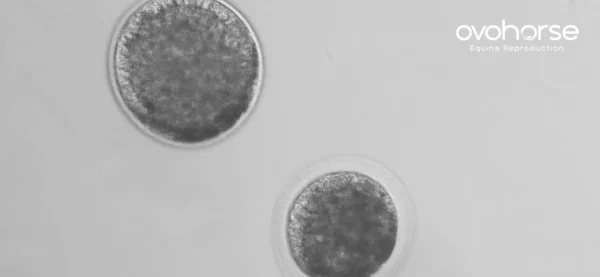The OPU-ICSI technique stands for two procedures used in equine assisted reproduction with the goal of achieving the desired offspring. OPU refers to “Ovum Pick Up,” which is the process of egg aspiration in mares. ICSI stands for Intracytoplasmic Sperm Injection, the union of the egg with the sperm in the laboratory to generate the embryo.
OPU-ICSI is a faster and more efficient process than the current equine reproduction technique: embryo transfer. In this article, we will explain step by step how this innovative reproduction technique works:
Step 1: Veterinary Check
Before starting the process, the donor mare must undergo a medical check to ensure she is in good health for the procedure.
Step 2: OPU
During this first phase, eggs are extracted using the follicular aspiration technique. Follicular aspiration (OPU) involves retrieving oocytes (eggs) directly from a mare’s ovaries through transvaginal aspiration (TVA). A long needle is introduced through the vaginal wall into the ovary to aspirate each follicle present, guided by ultrasound. The mare is sedated, and the procedure takes 20 to 60 minutes, depending on the number of follicles in the ovaries. An average of 5-6 eggs is typically obtained per aspiration.
- Step 3: Maturation + ICSI
The oocytes retrieved during the OPU session mature in the laboratory for approximately 30 hours, and then a single healthy-looking sperm is injected into each mature oocyte under the microscope using a micromanipulator.To perform ICSI, only one sperm per oocyte is needed, whereas conventional In Vitro Fertilization (IVF) requires thousands of sperm.
Thanks to Ovohorse’s techniques, we can also perform embryo biopsies to obtain male or female offspring to achieve the desired genetic traits.
Step 4: Embryo Freezing
The embryos resulting from ICSI can be vitrified for later transfer or preserved indefinitely in liquid nitrogen. Thanks to this freezing technique, embryos can be shipped in special containers to any part of the world. Another advantage is that the donor mare can continue her sports career while the recipient mare carries the embryo to term.With this equine assisted reproduction procedure, up to 10 oocytes can be obtained from a single extraction per month. Consequently, up to 20 embryos could be obtained in a year, although it all depends on the mare’s genetics and response.
Do you own a breeding farm? Contact us without obligation! info@ovohorse.com

